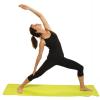CYBERMED LIFE - ORGANIC & NATURAL LIVING
CYBERMED LIFE - ORGANIC & NATURAL LIVING
 Pilates (/pɪˈlɑːtɪz/; German: [piˈlaːtəs]) is a physical fitness system developed in the early 20th century by Joseph Pilates, after whom it was named. Pilates called his method "Contrology". It is practiced worldwide, and especially in western countries such as Canada, the United States and the United Kingdom. As of 2005, there were 11 million people practicing the discipline regularly and 14,000 instructors in the United States.
Pilates (/pɪˈlɑːtɪz/; German: [piˈlaːtəs]) is a physical fitness system developed in the early 20th century by Joseph Pilates, after whom it was named. Pilates called his method "Contrology". It is practiced worldwide, and especially in western countries such as Canada, the United States and the United Kingdom. As of 2005, there were 11 million people practicing the discipline regularly and 14,000 instructors in the United States.
There is only limited evidence to support the use of Pilates to alleviate low back pain, or improve balance in elderly people. Evidence from studies show that while Pilates improves balance, limited data exists on whether this impacts on falls by the elderly. Pilates has not been shown to be an effective treatment for any medical condition. There is some evidence regular Pilates sessions can help muscle conditioning in healthy adults, when compared to doing no exercise.
Brief description
In his book Return to Life through Contrology, Joseph Pilates presents his method as the art of controlled movements, which should look and feel like a workout (not a therapy) when properly manifested. If practiced with consistency, Pilates improves flexibility, builds strength and develops control and endurance in the entire body. It puts emphasis on alignment, breathing, developing a strong core, and improving coordination and balance. The core, consisting of the muscles of the abdomen, low back, and hips, is often called the "powerhouse" and is thought to be the key to a person's stability. Pilates' system allows for different exercises to be modified in range of difficulty from beginner to advanced or to any other level, and also in terms of the instructor and practitioner's specific goals and/or limitations. Intensity can be increased over time as the body adapts itself to the exercises.
History
Pilates was developed by Joseph Pilates, from Mönchengladbach, Germany. His father was a gymnast and his mother a naturopath.
During the first half of the twentieth century, he developed a system of exercises which were intended to strengthen the human mind and body. Pilates believed that mental and physical health were interrelated.
In his youth he had practised many of the physical training regimes available in Germany, and it was from these he developed his own method. It has clear connections with the physical culture of the late nineteenth century, such as the use of special apparatuses and claims that the exercises could cure ill health. It is also related to the tradition of "corrective exercise" or "medical gymnastics" as typified by Pehr Henrik Ling.
Pilates said that the inspiration for his method came to him during World War One, while he was being held at the Knockaloe internment camp on the Isle of Man. He developed his method there for four years, working on his fellow internees .
Joseph Pilates accompanied his method with a variety of equipment, for which he used the term "apparatus". Each apparatus was designed to help accelerate the process of stretching, strengthening, body alignment and increased core strength started by the mat work. The best-known and most popular apparatus today, the Reformer, was originally called the Universal Reformer, aptly named for "universally reforming the body". Eventually Pilates designed other apparatus, including the Cadillac, Wunda Chair, High "Electric" Chair, Spine Corrector, Ladder Barrel and Pedi-Pole.
Pilates published two books related to his training method: Your Health: A Corrective System of Exercising That Revolutionizes the Entire Field of Physical Education in 1934, and Return to Life Through Contrology in 1945.
His first students went on to teach his methods, including: Romana Kryzanowska, Kathy Grant, Jay Grimes, Ron Fletcher, Maja Wollman, Mary Bowen, Carola Treir, Bob Seed, Eve Gentry, Bruce King, Lolita San Miguel, and Mary Pilates, Joseph's niece. Contemporary Pilates includes both the "Modern" Pilates and the "Classical/Traditional" Pilates. Modern Pilates is partly derived from the teaching of some first generation students, while Classical Pilates aims to preserve the original work as Joseph Pilates taught it.